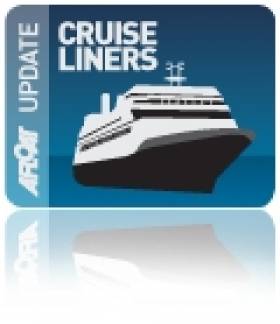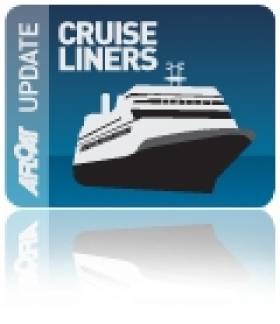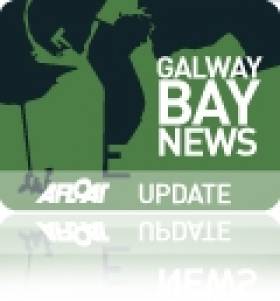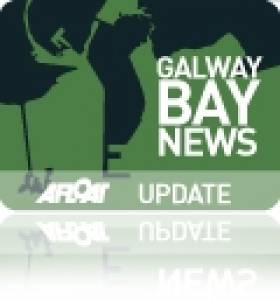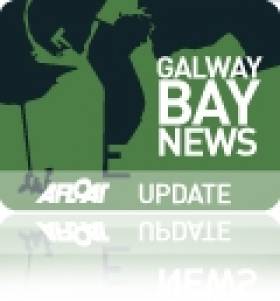Displaying items by tag: Galway Harbour
Call Opens Galway Harbour Cruiseship Season
#CRUISE LINERS – Galway Harbour Company welcomed the first cruise caller this year with the Silver Explorer an expedition cruiseship with a capacity for over 130 guests, writes Jehan Ashmore.
The 6,072 tonnes vessel is on a cruise from Bordeaux and her most recent ports of call have been to Glengariff and Waterford. This evening the ship heads for Killybegs where passengers will visit the north-west.
For the rest of the season Galway port is scheduled for eight more cruise calls. Two cruise calls are scheduled in mid-August while the Silver Explorer is to make a return visit later that month. She is no stranger to Irish waters having served as the former Prince Albert II.
From Falmouth to the Fjords
#CRUISE LINERS – Dublin Port's first cruise caller for this season will be Arion which today sets sail from Falmouth on an eleven night / twelve day cruise to Scotland and Norwegian fjords. The 5,888 gross tonnes cruiseship built in 1965 is to berth in the capital at Ocean Pier, writes Jehan Ashmore.
The veteran vessel which has sleek traditional lines can carry over 300 passengers and she is operated by Classic International Cruises. Her visit will be one of around 90 cruise calls scheduled to Dublin Port during this year's season which stretches to early October. The majority of these calls will be in the summer and where several ships will be making repeat port of calls.
With so many callers to Dublin Port, this brings a greater variety of vessels as evident between the Arion and Princess Cruises considerably larger Grand Princess which is due next week. The giant vessel weighs over 109,000 gross tonnes and has a capacity for over 4,000 passenger and crew.
The Portuguese flagged Arion is also set to open the season to Galway, as previously reported she is to make an anchorage call off the mid-west harbour next month.
Meanwhile following all the recent focus centred in Cobh, Cruise & Maritime Voyages Marco Polo is expected to arrive this afternoon by berthing at the town's dedicated cruiseship quayside.
#GALWAY HARBOUR - Galway Harbour management are looking forward to the prospect of Chinese investment in the port's redevelopment plans, the Galway Independent reports.
“Chinese investors clearly recognise not only the massive potential of ocean tourism, but also the specific potential for Galway as a destination port for cruise liners," said Fine Gael TD Brian Walsh, referring to discussions between the Government and Chinese officials in Beijing last week.
As previously reported on Afloat.ie, Galway Bay can expect to welcome at least nine cruise visits thus year, with the first scheduled to arrive late next month.
Walsh added: "Galway is an incredibly attractive city, and if we can make it accessible to the major players in the cruise-line market, the impact on the local economy would be immense.”
Galway Harbour Company CEO Eamon Bradshaw said that the port project had "illicited quite a bit of interest" when the company presented at the recent Chinese-Ireland Relations conference at NUI Galway.
"We’re confident that we do have a lot to offer and we are confident that an investor will come on board."
The Galway Independent has more on the story HERE.
Plans for New Galway Port Will Have to be Withdrawn
#GALWAY HARBOUR- A proposed €200m outer deepwater port will have to be withdrawn due to a failure by Galway Harbour Company to secure necessary approvals for preliminary investigations, according to a report in yesterday's Irish Times.
The ambitious plan, which intended to build following the success of the stopover of the Volvo Ocean Race in 2009 (and to return next July), was due to have been submitted directly to the planning appeals board some months ago under the Strategic Infrastructure Act.
However, the harbour company was advised that site investigation works for the application were conducted without first securing full approval for a foreshore licence from the Department of the Environment.
Taoiseach Enda Kenny is said to have been informed of the setback, which is expected to delay submission of a planning application to An Bord Pleanála until the mid-2012.
The development proposed transferring port operations outside from the existing single-dock facility (click HERE) south into Galway Bay, where reclaimed land in deeper waters would accommodate larger cruise-ships (click HERE) in addition a freight rail-link and a 200-berth marina.
Galwegian Special Olympian Athletes Celebrate On board Navy's Flagship
The world games which were held during June and July saw over 7,500 athletes from 185 countries participate in the Greek capital. Team Ireland in total brought home 107 medals, with athletes from Galway securing 11 medals and a number of ribbons in a variety of sports.
Speaking about the reception, Regional Director Myra Merrick said: "We are honoured to have the Naval Service docking in Galway especially for the function. The athletes deserve a warm reception and recognition for their wonderful success. It's a huge achievement in itself to participate at World Games level, let alone bring back a medal".
"The event presents an exceptional opportunity for the public to extend congratulations to our local sporting heroes, explore the Defence Forces vessel and meet the officers" she added.
The 1984 built /1,910 tonnes 'helicopter patrol vessel' and her seven fleetmates are all each assigned to a particular charity. In the case of L.E. Eithne she is associated with Our Lady's for Sick Children, Crumlin in Dublin.
Cruise-Goers Head for the Galway Races
The vessel first visited Galway in 2009 but this call will be her last year operating under the Spirit of Adventure cruise banner. The company are to replace the vessel next season with the Saga Pearl II which will be transferred from the parent company Saga Cruises and renamed Quest for Adventure.
Prior to the Spirit of Adventurer's call, the 226 passenger Le Diamant arrived from St. Malo last Friday. She became the first vessel to make a call to the 'City of the Tribes' on behalf of her French operators, Cie de Ponant. Her passengers were taken on tours of the city, Connemara and the Aillwee Caves in neighbouring Co. Clare. The vessel is due to return early next month.
With three cruise-calls this year the port is set to increase this figure to 7 in 2012 arising from the ports campaign over the last two years. Paul Carey, Chairman of the Harbour Company, said "We are beginning to see the fruits of this campaign and look forward to growing Galway's association with the return of the majestic passenger liners to Galway".
"The passenger liner The World has been confirmed for a two-day visit in August 2013 which is a great endorsement of Galway as a cruise destination".
The call by the world's first ocean-going luxury resort vessel will also be another first for Galway. Operators of the 43,524gt vessel, Residences at Sea have made previous Irish ports of call to include Dublin, for more on her to the capital last August click HERE.
- Dublin Port
- Galway Bay
- Foynes
- Shannon Estuary
- The World
- Cruiseships
- Ports and Shipping News
- city of the tribes
- Galway Harbour
- Galway Harbour News
- Mutton Island
- Le Diamant
- Cruiseliners
- Saga Cruises
- Spirit of Adventure Cruises
- Spirit of Adventure
- Galway Harbour and Bay news
- Galway Port
- Port of Galway Company
- Ponant Cruises
- Galway Races
- The Galway Races Ballybrit
- Ballybrit Race Course
- Port of Foynes
- Saga Pearl II
- Quest for Adventure
- Shannon Estuary and port news
- The World cruise liner
- Residences at Sea
- The World Residences at Sea
- Irish cruise ports of call
- Irish cruise calls
- Cruiseships to Ireland
- Cruise Companies visiting Ireland
- West of Ireland cruise callers
Mauritius-Bound Ferries Finally Bid Galway Farewell
First to be loaded was the Clann na nOileáin on Wednesday in an operation than took four-hours while on Friday her sister Clann Eagle I took six-hours to be winched safely onto the cargo-deck during freshening winds.
It is ironic that since Thor Gitta 's arrival to the port's Dún Aengus Dock on 5 April that it would also nearly be the same time taken for the estimated 25-day delivery voyage of the ferries to the Indian Ocean island.
During the 8,300 mile journey Thor Gitta will make several port of calls with the first call to La Rochelle. The Bay of Biscay port is the next largest port south of Les Sables d'Olonnes, where the fast-ferries where built at the OCEA boatyard for her original owners Bád Arann Teoranta which traded as Aran Direct on routes from Rossaveal to the islands.
Thor Gitta was built in 1996 and is also designed to carry 364 TEU (twenty-foot equivilant unit) containers and belongs to an-eight strong fleet operated by the Danish company, Thor Rederi A/S of Svendborg.
One of the reasons why the heavylift vessel was delayed in loading was to ensure the correct positioning of the ferries so not to further disrupt other port call cargo allocation while on the long repositioning voyage to Mauritius.
The 4,078 tonnes cargsoship is also scheduled to make en-route calls to Pointe Noir in the Congo, Cape Town and Pemba in Mozambique before finally reaching the southern Indian Ocean destination.
When the ferries were completed in 2005 and 2006 they were valued between €5-6m but they only served up to September 2008 when the 243 passenger aluminium built craft were laid-up at the Connemara harbour due to financial difficulities.
This led to the company going into receivership and the vessels were put up for auction in Galway last February. Despite bids reaching €950,000, they were withdrawn at the auction hosted by the Cork based auctioneer, Dominic J. Daly.
In the following month the fast-ferries were sold to the French owner for a new career based from the island state which is in the Mascarene Islands. Mauritius is neighboured by the smaller islands of Agalega, Cargados Carajos, Rodrigues and the French island of Réunion some 200km to the southwest.
Fishing Exhibition Show Heads for Galway
The exhibition times are Friday 4th March (10:00am - 5:30pm) and on Saturday 5th March the opening hours are repeated (10:00am - 5:30pm). For further information on the trade-only show Tel: (053) 74 954 8037 / 954 8935 or by clicking here
Public Views Galway Harbour Plans This Weekend
Plans for the development of Galway Harbour are open for public consultation this weekend, The Irish Times reports.
The Galway Harbour Company's €200 million scheme involves moving the port south onto 24 hectares of reclaimed land in deeper water to accommodate cruise liners.
A new rail link is also proposed, as well as an expanded marina with more than 200 berths.
The company's chief excecutive Eamon Bradshaw said the first stage of the plan would be self-financed, but did not rule out the possibility of EU funding, public-private partnerships and private investment.
Pending planning approval, development is hoped to begin at the end of 2012 - some months after Galway welcomes the return of the Volvo Ocean Race.
Thr Irish Times has more on the story HERE.


























